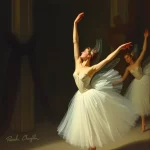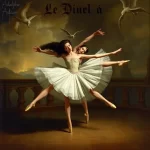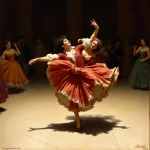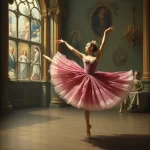Ballet: Les Sylphides (Frédéric Chopin, 1909)

Introduction
Les Sylphides is a one-act ballet that stands as a quintessential example of the romantic ballet tradition. Choreographed by Michel Fokine and set to the music of Frédéric Chopin, the ballet premiered on June 2, 1909, at the Théâtre du Châtelet in Paris. Unlike many narrative-driven ballets, Les Sylphides is a plotless ballet blanc, focusing instead on the ethereal beauty and poetic expression of the dancers, who embody sylphs—mythical air spirits.
Historical Background
Creation and Development
Les Sylphides was created during a period of significant transformation in the world of ballet. The early 20th century saw a shift from the grand, narrative ballets of the 19th century to more abstract and expressive forms. This ballet was heavily influenced by the romantic era’s fascination with the supernatural and the ethereal. The inspiration for Les Sylphides came from the romantic ballet La Sylphide, which also featured sylphs and was first performed in 1832.
Michel Fokine, the choreographer, sought to create a ballet that was purely about dance and music, devoid of a complex storyline. He collaborated closely with Sergei Diaghilev, the impresario of the Ballets Russes, and the composer Frédéric Chopin, whose piano pieces were orchestrated by Alexander Glazunov, Igor Stravinsky, and others to create the ballet’s score.
Premiere and Reception
Les Sylphides premiered on June 2, 1909, at the Théâtre du Châtelet in Paris as part of the Ballets Russes’ first Paris season. The initial reception was overwhelmingly positive, with critics and audiences alike praising its ethereal beauty and innovative choreography. Notable early performances featured legendary dancers such as Anna Pavlova, Tamara Karsavina, and Vaslav Nijinsky, who brought Fokine’s vision to life with their extraordinary talent.
Synopsis of the Ballet
Les Sylphides is a one-act ballet that does not follow a traditional narrative structure. Instead, it is a series of dance sequences that evoke the romantic and dreamlike atmosphere of a moonlit forest, where a poet finds himself surrounded by sylphs. The ballet is often described as a “romantic reverie” and is celebrated for its lyrical and expressive choreography.
Key Moments or Scenes
- Prelude: The ballet opens with a serene and contemplative prelude, setting the tone for the dreamlike atmosphere.
- Waltz: The sylphs perform a graceful waltz, showcasing their ethereal beauty and delicate movements.
- Mazurka: A lively and spirited dance that contrasts with the more subdued sections of the ballet.
- Nocturne: A hauntingly beautiful solo that captures the essence of the romantic spirit.
- Finale: The ballet concludes with a poignant and reflective finale, leaving the audience with a sense of wistful longing.
Musical Composition
Composer’s Role
Frédéric Chopin, a Polish composer and virtuoso pianist of the Romantic era, composed the music for Les Sylphides. Although Chopin did not write music specifically for the ballet, his piano pieces were orchestrated to create the score. The orchestrations were done by several composers, including Alexander Glazunov, Igor Stravinsky, and Maurice Ravel, among others. Chopin’s music, known for its lyrical beauty and emotional depth, perfectly complements the ethereal and poetic nature of the ballet.
Musical Themes and Motifs
The music of Les Sylphides features several recurring themes and motifs that enhance the ballet’s narrative and emotional impact. The use of Chopin’s nocturnes, waltzes, and mazurkas creates a rich tapestry of sound that evokes the romantic and dreamlike atmosphere of the ballet. The music’s delicate and expressive qualities mirror the movements of the dancers, creating a seamless blend of sound and motion.
Famous Recordings and Performances
There have been numerous iconic recordings and performances of Les Sylphides over the years. Notable recordings include those conducted by renowned maestros such as Sir John Barbirolli and Leonard Bernstein. Famous performances have featured legendary dancers like Margot Fonteyn, Rudolf Nureyev, and Mikhail Baryshnikov, who have all brought their unique interpretations to the ballet.
Choreography and Dance
Choreographer’s Vision
Michel Fokine’s vision for Les Sylphides was to create a ballet that was purely about dance and music, free from the constraints of a traditional narrative. He sought to capture the essence of the romantic spirit through lyrical and expressive choreography. Fokine’s innovative approach included the use of fluid and natural movements, as well as a focus on the emotional and poetic qualities of the dance.
Signature Dance Numbers
- Pas de Deux: A beautiful and intimate dance between the poet and a sylph, showcasing their connection and the ethereal nature of the sylphs.
- Solo Performances: Each sylph has a solo performance that highlights their individual grace and beauty.
- Group Dances: The sylphs perform several group dances that emphasize their unity and otherworldly presence.
Notable Interpretations
Over the years, different productions of Les Sylphides have interpreted and adapted the choreography in various ways. Some productions have emphasized the romantic and dreamlike qualities of the ballet, while others have focused on the technical precision and virtuosity of the dancers. Notable interpretations include those by the Royal Ballet, the Bolshoi Ballet, and the American Ballet Theatre, each bringing their unique style and vision to the ballet.
Characters and Roles
Main Characters
- The Poet: The central figure in the ballet, the poet is a dreamer who finds himself surrounded by sylphs in a moonlit forest. His interactions with the sylphs form the core of the ballet’s emotional and poetic expression.
- The Sylphs: Ethereal and otherworldly beings, the sylphs are the embodiment of beauty and grace. They dance around the poet, creating a dreamlike and romantic atmosphere.
Supporting Characters
As a plotless ballet, Les Sylphides does not have traditional supporting characters. The focus is primarily on the poet and the sylphs, with each sylph having moments to shine through solo performances and group dances.
Famous Dancers
Many renowned dancers have portrayed the roles in Les Sylphides over the years. Notable performers include Anna Pavlova, Tamara Karsavina, Vaslav Nijinsky, Margot Fonteyn, Rudolf Nureyev, and Mikhail Baryshnikov. Each of these dancers has brought their unique artistry and interpretation to the ballet, contributing to its enduring legacy.
Cultural and Artistic Impact
Influence on Ballet and Dance
Les Sylphides has had a profound influence on the world of ballet and dance. Its emphasis on pure dance and music, free from narrative constraints, paved the way for future abstract and plotless ballets. The ballet’s lyrical and expressive choreography has inspired countless choreographers and dancers, contributing to the evolution of ballet as an art form.
Cultural Significance
Les Sylphides holds a special place in popular culture and the arts. Its romantic and dreamlike qualities have made it a favorite subject for artists, writers, and filmmakers. The ballet has been referenced in literature, film, and other media, further cementing its status as a cultural icon.
Legacy and Revivals
The legacy of Les Sylphides continues to thrive through numerous revivals and reinterpretations. Major ballet companies around the world regularly perform the ballet, keeping its spirit alive for new generations of audiences. Modern adaptations have also explored new interpretations of the choreography and music, ensuring that Les Sylphides remains a vital and relevant work in the world of dance.
Iconic Productions
Historic Productions
Some of the most famous historical productions of Les Sylphides include those by the Ballets Russes, the Royal Ballet, and the Bolshoi Ballet. These productions featured legendary dancers and choreographers who brought their unique vision to the ballet. Key figures involved in these productions include Sergei Diaghilev, Michel Fokine, Anna Pavlova, and Vaslav Nijinsky.
Contemporary Productions
Recent and current productions of Les Sylphides continue to captivate audiences with their innovative interpretations. Contemporary productions often incorporate modern elements in set, costume, and lighting design while staying true to the ballet’s romantic and ethereal essence. Companies like the American Ballet Theatre and the Paris Opera Ballet have presented acclaimed modern versions of the ballet.
Production Design
The set, costume, and lighting design in various productions of Les Sylphides play a crucial role in creating the ballet’s dreamlike atmosphere. Traditional productions often feature moonlit forest settings, flowing white costumes for the sylphs, and soft, ethereal lighting. Modern productions may experiment with different design elements to bring a fresh perspective to the ballet while maintaining its romantic and poetic qualities.
Critical Reception and Reviews
Initial Critical Response
At the time of its premiere, Les Sylphides received widespread acclaim from critics and audiences. The ballet was praised for its innovative choreography, beautiful music, and the exceptional performances of its dancers. Critics lauded Fokine’s vision and the seamless integration of Chopin’s music with the dance.
Modern Reviews
Contemporary critics and audiences continue to hold Les Sylphides in high regard. The ballet is celebrated for its timeless beauty and its ability to evoke deep emotions through its lyrical choreography and music. Modern reviews often highlight the ballet’s enduring relevance and its influence on the development of ballet as an art form.
Fun Facts and Trivia
Behind-the-Scenes Stories
One interesting anecdote from the production of Les Sylphides involves Anna Pavlova, who was initially hesitant to perform in the ballet due to its lack of a traditional narrative. However, after seeing Fokine’s vision and the beauty of the choreography, she became one of its most ardent supporters and one of its most famous interpreters.
Notable Performers
Over the years, many famous dancers, conductors, and directors have been associated with Les Sylphides. Notable performers include Margot Fonteyn, Rudolf Nureyev, Mikhail Baryshnikov, and Natalia Makarova. Each of these artists has left their mark on the ballet, contributing to its rich history and legacy.
Trivia
- Title Variations: The ballet is sometimes referred to as Chopiniana, especially in Russian productions.
- Orchestrations: The music for Les Sylphides was orchestrated by several composers, including Alexander Glazunov, Igor Stravinsky, and Maurice Ravel.
- Plotless Ballet: Les Sylphides is one of the earliest examples of a plotless ballet, focusing solely on dance and music.
Conclusion
Summary of the Ballet’s Importance
Les Sylphides is a significant work in the world of ballet for its innovative approach to choreography and its emphasis on pure dance and music. The ballet’s ethereal beauty, lyrical choreography, and emotional depth have made it a timeless classic that continues to inspire dancers, choreographers, and audiences alike.
Final Thoughts
Les Sylphides remains a beloved and enduring work in the ballet repertoire. Its ability to evoke deep emotions and create a dreamlike atmosphere through dance and music is a testament to the genius of Michel Fokine and Frédéric Chopin. For those who have not yet experienced this masterpiece, watching a performance or listening to the score is highly recommended.
FAQ
What is the central theme of this ballet?
The central theme of Les Sylphides is the romantic and dreamlike atmosphere created by the interactions between a poet and ethereal sylphs in a moonlit forest.
Who are the main characters in this ballet?
The main characters in Les Sylphides are the poet and the sylphs, who embody beauty, grace, and otherworldly presence.
What is the most famous dance number in this ballet?
One of the most famous dance numbers in Les Sylphides is the Pas de Deux, a beautiful and intimate dance between the poet and a sylph.
How long does a typical performance of this ballet last?
A typical performance of Les Sylphides lasts approximately 30 to 40 minutes.
Are there any modern adaptations of this ballet?
Yes, there have been several modern adaptations of Les Sylphides, with contemporary productions incorporating new design elements and interpretations while staying true to the ballet’s romantic essence.
Why is this ballet considered important in the history of dance?
Les Sylphides is considered important in the history of dance for its innovative approach to choreography, its emphasis on pure dance and music, and its influence on the development of abstract and plotless ballets.





